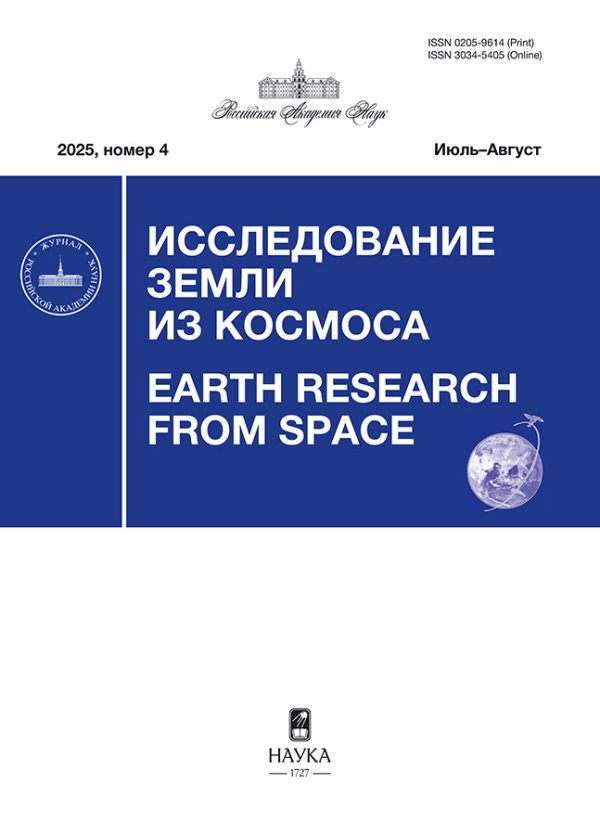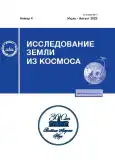Применение модели пространственно-иерархического квадродерева с усеченными ветвями для повышения точности классификации изображений
- Авторы: Достовалова А.М.1
-
Учреждения:
- АО “Концерн “Моринформсистема-Агат”
- Выпуск: № 4 (2023)
- Страницы: 83-91
- Раздел: МЕТОДЫ И СРЕДСТВА ОБРАБОТКИ И ИНТЕРПРЕТАЦИИ КОСМИЧЕСКОЙ ИНФОРМАЦИИ
- URL: https://journals.rcsi.science/0205-9614/article/view/136983
- DOI: https://doi.org/10.31857/S0205961423040036
- EDN: https://elibrary.ru/XKXXHR
- ID: 136983
Цитировать
Полный текст
Аннотация
В статье рассмотрена задача повышения точности классификации отсчетов спутниковых изображений в предположении независимости их отсчетов. Приращение точности достигалось за счет дополнительной обработки изображения как пространственно-иерархического квадродерева, являющегося видом случайного поля Маркова. Была предложена модификация этой модели – пространственно-иерархическое квадродерево с усеченными ветвями. Для исходной и модифицированной модели проведено сравнение результатов классификации реального радиолокационного изображения, характеризующегося большим количеством шумов. Точность классификации оценивалась как доля верно классифицированных отсчетов внутри выделенных однородных областей. Установлено, что в рамках модифицированной модели правильнее классифицируются однородные участки изображений за счет переноса на них свойств накопленных изображений того же региона. Модифицированная модель позволяет получить результат классификации более высокой точности, нежели исходная при обработке зашумленных изображений, при этом обладая меньшей ресурсоемкостью.
Ключевые слова
Об авторах
А. М. Достовалова
АО “Концерн “Моринформсистема-Агат”
Автор, ответственный за переписку.
Email: dost.bmstu99@gmail.com
Россия, Москва
Список литературы
- Джонсон Н.Л., Коц С., Балакришнан Н. Одномерные непрерывные распределения, часть 1. 4 изд. М.: Лаборатория знаний, 2017. 706 с.
- Достовалова А.М. Моделирование локально-однородных радиолокационных изображений при использовании различных статистических критериев // Математическое моделирование и численные методы. 2021. № 4.
- Королев В.Ю., Назаров А.Л. Разделение смесей вероятностных распределений при помощи сеточных методов моментов и максимального правдоподобия // Автоматика и телемеханика. 2010. № 3. С. 98–116.
- Bouman C., Shapiro M. A multiscale image model for Bayesian image segmentation // IEEE Trans. Image Processing. 1994. V. 3. P. 162–177.
- Anthony D’Angelo A Brief Introduction to Quadtrees and Their Applications // 28th Canadian Conference on Computational Geometry. 2016.
- Gui Gao. Statistical modeling of SAR Images: A Survey // Sensors. 2010. V. 10. P. 775−795.
- Hedhli I., Moser G., Zerubia J., Serpico S.B. A new cascade model for the hierarchical joint classification of multitemporal and multiresolution remote sensing data // IEEE Trans. Geosci. Remote Sens. 2016. V. 54. № 11. P. 6333–6348.
- Jean-Marc Laferté, Patrick Pérez, Fabrice Heitz Discrete Markov Image Modeling and Inference on the Quadtree // IEEE Transactions on image processing. 2000. V. 3. № 9. P. 390–404.
- Gabriele Moser, Sebastiano B. Serpico, Jo’n Atli Benediktsson Land-Cover Mapping by Markov Modeling of Spatial–Contextual Information in Very-High-Resolution Remote Sensing Images // Proceedings of the IEEE. 2013. № 3. P. 631–651.
- Pastorino M., Montaldo A., Fronda L., Hedhli I., Moser G., Serpico S.B., Zerubia J. Multisensor and Multiresolution Remote Sensing Image Classification through a Causal Hierarchical Markov Framework and Decision Tree Ensembles // Remote Sens. 2021. № 13. P. 849.
- Yong X. Polarimetric SAR image semantic segmentation with 3D discrete wavelet transform and Markov random field // IEEE Transactions on Image Processing. 2020. P. 1–14.
- Rignot E., Chelapia R. Maximum a posteriori classification of multifrequency, multilook, synthetic aperture radar intensity data // Optical society of America. 1993. V. 10. № 4.
Дополнительные файлы















